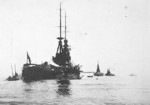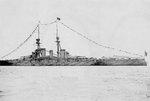Kongo
| Country | Japan |
| Ship Class | Kongo-class Battleship |
| Builder | Barrow-in-Furness, England |
| Launched | 1 Aug 1913 |
| Sunk | 21 Nov 1944 |
| Displacement | 36,601 tons standard |
| Length | 728 feet |
| Beam | 101 feet |
| Draft | 31 feet |
| Speed | 30 knots |
| Crew | 1,360 |
Contributor: C. Peter Chen
ww2dbaseKongo, first of a class of four 26,230 ton battlecruisers, was built at Barrow-in-Furness, England. The last major Japanese warship to be constructed abroad, she was completed in August 1913. She was active during World War I and afterwards as one of the fastest units of Japan's battle fleet. In 1929-31, Kongo was modernized at Yokosuka Dockyard, and was thereafter rated as a battleship. She was again modernized at Yokosuka in 1936-37, receiving new machinery and a lengthened hull to increase her speed to over thirty knots. This high speed, plus their heavy guns, made Kongo and her sisters uniquely valuable warships, and they were heavily used in World War II combat operations.
ww2dbaseAt the outbreak of hostilities between Japan and the Western Allies in December 1941, Kongo supported the landings on the Malayan Peninsula. As Japan's great southern offensive progressed, she covered the invasion of Java, fired her 14-inch guns in a bombardment of Christmas Island, and was part of the raid against British shipping in the Indian Ocean and Bay of Bengal. In the Battle of Midway in early June 1942, Kongo was part of Vice Admiral Nobutake Kondo's Covering Group.
ww2dbaseDuring the fiercely contested campaign over Guadalcanal that began in August 1942 Kongo helped deliver an intense and effective bombardment of Henderson Field on 14 October 1942, took part in the Battle of the Santa Cruz Islands later in that month and was part of the Japanese aircraft carrier force during the Naval Battle of Guadalcanal in mid-November. She was not in combat during 1943 and the first part of 1944, but participated in the Battle of the Philippine Sea in mid-June 1944 as part of the Japanese vanguard carrier division.
ww2dbaseAfter the 20 October 1944 invasion of Leyte, Kongo sortied with the rest of the Japanese fleet to make a counter-attack. This resulted in the great Battle of Leyte Gulf, an action that essentially destroyed Japan's Navy as a major fighting force. As part of the Center Force, Kongo survived a submarine attack on 23 October, carrier air attacks in the Sibuyan Sea the next day, the Battle off Samar against U.S. escort carriers and destroyers on 25 October and an Air Force high-level bombing attack as she withdrew from the battle area on the 26th. However, her luck ran out a month later. On 21 Nov 1944, soon after passing through the Taiwan Strait en route to Japan, she was torpedoed by the U.S. submarine Sealion. The resulting fires apparently were uncontrollable, as Kongo blew up and quickly sank a few hours after she was hit. The veteran of the Battle off Samar was the only battleship sunk by submarine attack during the Pacific War.
ww2dbaseSource: Naval Historical Center
Last Major Revision: Jun 2005
Battleship Kongo Interactive Map
Photographs
 |  |  |  |
Kongo Operational Timeline
| 12 Apr 1923 | Crown Prince Hirohito departed Japan aboard battleship Kongo. |
| 27 Apr 1923 | Crown Prince Hirohito boarded battleship Kongo at Kirun (now Keelung), Taiwan and departed for Japan. |
| 1 May 1923 | Crown Prince Hirohito arrived at Yokosuka, Japan aboard battleship Kongo. |
| 10 Dec 1941 | Japanese submarine I-58 spotted British battleship HMS Prince of Wales and battlecruiser HMS Repulse off British Malaya, launched five torpedoes, but all of them missed; beginning at 1117 hours, Japanese aircraft began to attack. Overwhelmed, HMS Repulse was sunk at 1233 hours (513 killed), followed by HMS Prince of Wales at 1318 hours (327 killed); destroyers HMS Electra, HMS Express, and HMS Vampire rescued 1,862 survivors. On land, the British commanders dispatched the 1st Battalion of the 14th Punjab Regiment and the 2nd Battalion of the 1st Gurkha Rifles regiment to Changlun and Asun in northern British Malaya to counter the Japanese advance; contact was made at Changlun at 2100 hours, where two Japanese tanks were destroyed before the Punjabi troops fell back toward Asun. |
| 26 Mar 1942 | Vice Admiral Chuichi Nagumo's Japanese First Air Fleet, built around a nucleus of five aircraft carriers (Akagi, Hiryu, Soryu, Shokaku, and Zuikaku), and supported by battleships (Kongo, Hiei, Haruna, and Kirishima), cruisers (Tone, Chikuma, Abukuma), and destroyers, sailed from Staring Bay, Celebes, Dutch East Indies to the west of Timor into the Indian Ocean with the intention of attacking the Royal Navy's bases at Colombo and Trincomalee in Ceylon. |
| 3 Apr 1942 | The Japanese fleet under the command of Vice Admiral Chuichi Nagumo entered the Indian Ocean. |
| 5 Apr 1942 | In the morning, Japanese carriers launched 36 D3A2 dive bombers and 53 B5N2 torpedo bombers, escorted by 36 Zero fighters, against the British naval base at Colombo, Ceylon, sinking merchant cruiser HMS Hector, damaging port facilities, while shooting down 25 British aircraft; 7 Japanese aircraft were lost in this attack. Around noon, cruiser Tone's floatplane spotted British cruisers HMS Cornwall and HMS Dorsetshire 200 miles southwest of Ceylon; 53 carrier aircraft were launched to attack, sinking Dorsetshire at 1350 hours (234 killed) and Cornwall at 1400 hours (190 killed); 1,122 survived from both ships. |
| 9 Apr 1942 | Japanese carrier aircraft attacked the harbor at Trincomalee, Ceylon at 0700 hours. Two hours later, empty British aircraft carrier HMS Hermes and Australian destroyer HMAS Vampire were detected 90 miles further south. At 1035 hours, Japanese carrier aircraft attacked and sank HMS Hermes (307 killed) and HMAS Vampire (9 killed); hospital ship Vita rescued survivors from both warships. At 1207 hours, 20 Japanese carrier dive bombers sank British oiler Athelstane (all aboard survived) and British corvette HMS Hollyhock (48 were killed, 17 survived) in the Indian Ocean. |
| 19 Mar 1943 | Kongo departed Sasebo, Japan for the West Inland Sea, with Yugure and Hagikaze in escort. |
| 20 Mar 1943 | Kongo arrived at the West Inland Sea, with Yugure and Hagikaze in escort. |
| 21 Jun 1943 | 170 miles northwest of the Japanese base at Truk, submarine USS Spearfish detected a formation of 11 to 13 Japanese warships, including the carriers Ryuho, Unyo, and Chuyo, battleships Kongo and Haruna, cruiser Kumano, plus destroyers. The task force steamed directly over Spearfish and when the submarine was in the middle of the formation, she fired four torpedoes at the lead carrier but missed. While setting up for a shot at the second carrier, Spearfish was forced to go deep by an approaching cruiser on a collision course. The Japanese task force arrived safely at Truk later that same day without ever detecting Spearfish's presence. |
Please consider supporting us on Patreon. Even $1 per month will go a long way! Thank you. Please help us spread the word: Stay updated with WW2DB: |
Visitor Submitted Comments
All visitor submitted comments are opinions of those making the submissions and do not reflect views of WW2DB.
» Abe, Hiroaki
» Arima, Masafumi
» Daigo, Tadashige
» Hara, Chuichi
» Kondo, Nobutake
» Koyanagi, Tomiji
» Kusaka, Ryunosuke
» Matsuda, Chiaki
» Tanaka, Raizo
Event(s) Participated:
» Battle of Coral Sea
» Battle of Midway and the Aleutian Islands
» Mariana Islands Campaign and the Great Turkey Shoot
Document(s):
» Interrogation Nav 83, Captain Nobuye Ukita
Related Books:
» Imperial Japanese Navy Battleships 1941-45
Partner Sites Content:
» Kongo Tabular Record of Movement
- » 1,167 biographies
- » 337 events
- » 44,617 timeline entries
- » 1,244 ships
- » 350 aircraft models
- » 207 vehicle models
- » 376 weapon models
- » 123 historical documents
- » 261 facilities
- » 470 book reviews
- » 28,518 photos
- » 365 maps
Captain Henry P. Jim Crowe, Guadalcanal, 13 Jan 1943
Please consider supporting us on Patreon. Even $1 a month will go a long way. Thank you!
Or, please support us by purchasing some WW2DB merchandise at TeeSpring, Thank you!
2 Jun 2021 09:19:55 AM
How high was her freeboard of the aftships section?